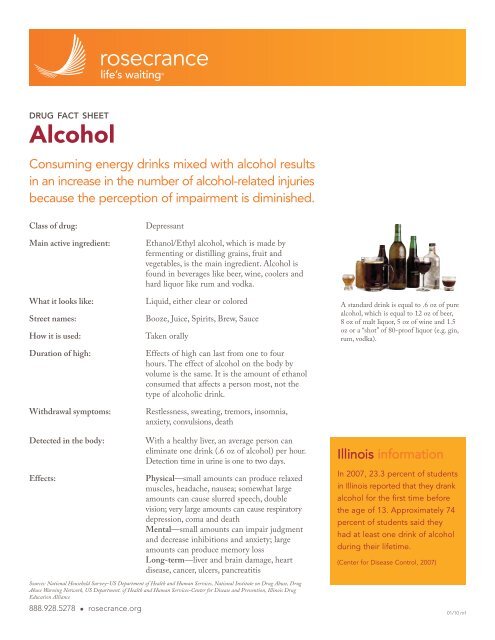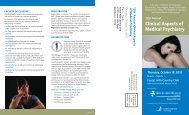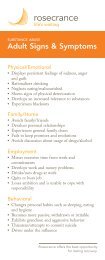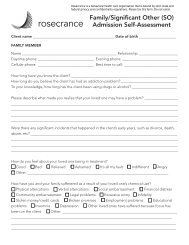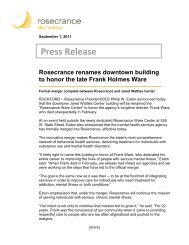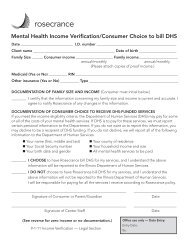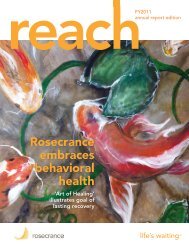Drug Fact Sheet - Rosecrance Health Network
Drug Fact Sheet - Rosecrance Health Network
Drug Fact Sheet - Rosecrance Health Network
Create successful ePaper yourself
Turn your PDF publications into a flip-book with our unique Google optimized e-Paper software.
®<br />
DRUG FACT SHEET<br />
Alcohol<br />
Consuming energy drinks mixed with alcohol results<br />
in an increase in the number of alcohol-related injuries<br />
because the perception of impairment is diminished.<br />
Class of drug:<br />
Main active ingredient:<br />
What it looks like:<br />
Street names:<br />
How it is used:<br />
Duration of high:<br />
Withdrawal symptoms:<br />
Detected in the body:<br />
Effects:<br />
Depressant<br />
Ethanol/Ethyl alcohol, which is made by<br />
fermenting or distilling grains, fruit and<br />
vegetables, is the main ingredient. Alcohol is<br />
found in beverages like beer, wine, coolers and<br />
hard liquor like rum and vodka.<br />
Liquid, either clear or colored<br />
Booze, Juice, Spirits, Brew, Sauce<br />
Taken orally<br />
Effects of high can last from one to four<br />
hours. The effect of alcohol on the body by<br />
volume is the same. It is the amount of ethanol<br />
consumed that affects a person most, not the<br />
type of alcoholic drink.<br />
Restlessness, sweating, tremors, insomnia,<br />
anxiety, convulsions, death<br />
With a healthy liver, an average person can<br />
eliminate one drink (.6 oz of alcohol) per hour.<br />
Detection time in urine is one to two days.<br />
Physical—small amounts can produce relaxed<br />
muscles, headache, nausea; somewhat large<br />
amounts can cause slurred speech, double<br />
vision; very large amounts can cause respiratory<br />
depression, coma and death<br />
Mental—small amounts can impair judgment<br />
and decrease inhibitions and anxiety; large<br />
amounts can produce memory loss<br />
Long-term—liver and brain damage, heart<br />
disease, cancer, ulcers, pancreatitis<br />
A standard drink is equal to .6 oz of pure<br />
alcohol, which is equal to 12 oz of beer,<br />
8 oz of malt liquor, 5 oz of wine and 1.5<br />
oz or a “shot” of 80-proof liquor (e.g. gin,<br />
rum, vodka).<br />
Illinois information<br />
In 2007, 23.3 percent of students<br />
in Illinois reported that they drank<br />
alcohol for the first time before<br />
the age of 13. Approximately 74<br />
percent of students said they<br />
had at least one drink of alcohol<br />
during their lifetime.<br />
(Center for Disease Control, 2007)<br />
Sources: National Household Survey–US Department of <strong>Health</strong> and Human Services, National Institute on <strong>Drug</strong> Abuse, <strong>Drug</strong><br />
Abuse Warning <strong>Network</strong>, US Department. of <strong>Health</strong> and Human Services-Center for Disease and Prevention, Illinois <strong>Drug</strong><br />
Education Alliance<br />
888.928.5278 l rosecrance.org<br />
01/10 mf
®<br />
DRUG FACT SHEET<br />
Bath Salts<br />
Illegal in Illinois but legal in most states, “bath<br />
salt” is one of the latest designer drugs. It can<br />
be found at gas stations and convenience stores.<br />
Class of drug:<br />
Main active ingredients:<br />
What it looks like:<br />
Street names:<br />
How it is used:<br />
Duration of high:<br />
Withdrawal symptoms:<br />
Detected in the body:<br />
Effects:<br />
Synthetic Stimulant<br />
MDPV (methylenedioxypyrovalerone) and<br />
mephedrone (which are found in a lower dosage<br />
in legitimate bath salts and plant foods)<br />
White, powdery or crystallized substance packaged<br />
as bath salt<br />
Ivory Wave, Bolivian Bath, Vanilla Sky, Legal<br />
Cocaine, Snow White, Hurricane Charlie, Bliss,<br />
Pure White, Purple Iris, XXX-rated plant food<br />
Inhaled, injected, eaten in food and swallowed in<br />
drinks. Bath Salt can be rolled into joints with<br />
marijuana and smoked, too (called Head<br />
Trip Potpourri).<br />
The initial rush peaks within 15 minutes to one<br />
hour and can last for five hours. Many users<br />
re-dose to extend the effects for a few days.<br />
Fatigue, depression, anxiety, psychotic behaviors<br />
Yes, through quantitative testing for MDPV,<br />
Mephedrone and Methylone, but it is not detected<br />
in routine drug tests<br />
Mimics the high of cocaine, ecstasy and<br />
amphetamines<br />
Physical—Chest pains, headaches, high blood<br />
pressure, increased pulse, muscle twitching,<br />
cravings, insomnia, seizures<br />
Mental—Agitation, delusions, anxiety, paranoia,<br />
hallucinations, violent rages, suicidality<br />
Long-term—Fairly new drug, no long-term<br />
effects have been recorded in humans.<br />
By marketing the designer drugs as bath salts<br />
and labeling them “not for human consumption,”<br />
manufacturers and retailers have been<br />
able to bypass food and drug regulations and<br />
sell the drug legally in most states. Bath salts<br />
cost approximately $20 - $40 a pack.<br />
Illinois information<br />
Illinois is the 11th state to ban<br />
“bath salts.” The new law adds<br />
chemical compounds used in<br />
making bath salts, such as MDPV,<br />
to the list of the state’s Schedule I<br />
controlled substances. The<br />
American Association of Poison<br />
Control Centers reported 3,470<br />
calls about bath salt during the<br />
first six months of 2011.<br />
Sources: http://www.doctoroz.com/videos/alternate-names-bath-salt-drug; http://www.webmd.com/mental-health/features/bath-saltsdrug-dangers;<br />
US Department of Justice; Quick <strong>Fact</strong> Alert: Bath Salts, Chestnut <strong>Health</strong> Systems; www.sober.com/bath-salts.html<br />
(Join Together, July 26, 2011,<br />
www.drugfree.org/join-together)<br />
888.928.5278 l rosecrance.org<br />
01/12 mf
®<br />
DRUG FACT SHEET<br />
Bromo-Dragonfly<br />
Bromo-Dragonfly is an extremely potent and long-acting<br />
psychedelic. The unscheduled research chemical is not<br />
formally controlled in the US and is available online.<br />
Class of drug:<br />
Main active ingredients:<br />
Synthetic Hallucinogen<br />
1-(8-bromobenzo (1,2 – b; 4,5- b) difuran-4-yl)-<br />
2-aminopropane. Its name is derived from the<br />
dragonfly-like appearance of its chemical structure.<br />
What it looks like:<br />
Street names:<br />
How it is used:<br />
Duration of high:<br />
Detected in the body:<br />
Effects:<br />
888.928.5278 l rosecrance.org<br />
In its purest form, this is a white powder, but it<br />
can be colored or mixed with other ingredients<br />
that may change its appearance. It also may be<br />
dissolved and made into a liquid.<br />
Bromo-Dragonfly, DOB-Dragonfly, Fly, BDF<br />
Oral ingestion by blotter paper, powder or liquid<br />
Dragonfly is a drug similar to LSD in potency.<br />
However, it differs from LSD in that it has a much<br />
longer duration of action. Some reports state that<br />
the effects can last several days, yet it may take<br />
several hours before the action is noted.<br />
It can be detected using sophisticated serum<br />
techniques, but it currently can not be detected<br />
with simple urine tests.<br />
Physical—agitation, tonic-clonic seizures,<br />
vasoconstriction, necrosis, death<br />
Mental—severe, vivid and often frightening<br />
hallucinations<br />
Long-term—This drug is fairly new; the<br />
DEA is still studying the long-term effects.<br />
Sources: Andreasen MF, Telving R, Birkler RI, Schumacher B, Johannsen M. A fatal poisoning involving Bromo-Dragonfly.<br />
Forensic Sci Int. 2009 Jan 10;183(1-3):91-6; Wood DM, Looker JJ, Shaikh L, Button J, Puchnarewicz M, Davies S, Lidder S,<br />
Ramsey J, Holt DW, Dargan PI. Delayed onset of seizures and toxicity associated with recreational use of Bromo-dragonFLY. J Med<br />
Toxicol. 2009 Dec 5(4):226-9;Corazza O, Schifano F, Farre M, Deluca P, Davey Z, Torrens M, Demetrovics Z, Di Furia L,<br />
Flesland L, Siemann H, Skutle A, Van Der Kreeft P, Scherbaum N. Designer drugs on the internet: a phenomenon out-of-control?<br />
the emergence of hallucinogenic drug Bromo-Dragonfly. Curr Clin Pharmacol. 2011 May 6(2):125-9; http://www.drugsforum.com/forum/showwiki.php?title=Bromo-Dragonfly<br />
Given the drug’s extreme potency and narrow<br />
safety window, accurate measurement of doses<br />
is critical. Even a dose a few milligrams off<br />
can be life-threatening. Also, the slow onset<br />
of the high may lead some users to re-dose,<br />
which can result in death. Mislabeling<br />
of Bromo-Dragonfly as its far-less-potent<br />
2C-B-FLY has led to fatalities and<br />
hospitalizations.<br />
U.S. information<br />
In 2011, two young adults died<br />
after overdosing on Bromo-<br />
Dragonfly, which they thought<br />
was a similar drug. Several others<br />
were hospitalized during the<br />
same incident. Both deaths were<br />
preceded by massive seizures,<br />
vomiting blood and terrifying<br />
hallucinations. Several survivors<br />
suffered from its effects days<br />
after using the drug.<br />
(Oklahoma NewsOn6.com, May 13, 2011<br />
Second victim dies after taking designer<br />
drug in Konawa)<br />
01/12 tw
®<br />
DRUG FACT SHEET<br />
Club <strong>Drug</strong>s<br />
Club drugs like GHB and Rohypnol are used in<br />
date rapes, because they are sedatives and can<br />
make one unconscious and immobile.<br />
Class of drug:<br />
Main active ingredient:<br />
What it looks like:<br />
Street names:<br />
How it is used:<br />
Duration of high:<br />
Withdrawal symptoms:<br />
Effects:<br />
MDMA (Stimulant), GHB (Depressant), Rohypnol<br />
(Benzodiazepines), Ketamine (Dissociative), LSD<br />
(Hallucinogen)<br />
Varies as drug varies. Since club drugs are often<br />
manufactured in makeshift labs, it is impossible to know<br />
what chemicals are used to produce them and the consequences<br />
of each drug.<br />
Most liquid club drugs are odorless, colorless and tasteless,<br />
which makes it easy to slip into a drink. Many<br />
of the powdered forms are easily dissolved in liquids.<br />
Club drugs are also available in pill/capsule form as well<br />
as blotter paper.<br />
MDMA—Ecstasy, E, X; GHB—Liquid Ecstasy, Grievous<br />
Bodily Harm; Ketamine—K, Special K, Kit Kat;<br />
Rohypnol—Roofies, R-2; LSD—Acid, Blotter, Microdot<br />
Taken orally in pill form (MDMA, GHB, LSD), liquid<br />
form (GHB, LSD), powdered form (GHB) and blotter<br />
paper (LSD). Ketamine can be smoked, injected or snorted.<br />
Most club drugs effects are felt within 10 to 20 minutes<br />
and last from three to six hours. Rohypnol is felt within<br />
30 to 90 minutes and can impair a user for eight to 12 hours.<br />
Sleep problems, depression, anxiety<br />
Different club drugs have different effects:<br />
Physical—loss of muscle and motor control, blurred<br />
vision, dehydration, drowsiness, breathing problems,<br />
unconsciousness, increased heart rate, blood pressure and<br />
body temperature<br />
Mental—hallucinations, aterograde amnesia, euphoria,<br />
impaired senses, memory and judgment<br />
Long-term—sleep problems, heart and kidney failure,<br />
brain damage, paranoia, coma, death<br />
Many of these “club drugs” are used recreationally,<br />
by choice, at all-night dance<br />
parties (raves) bars and concerts.<br />
Illinois information<br />
The use of club drugs and more<br />
specifically designer drugs has<br />
increased sharply in the greater<br />
Chicagoland area as well as<br />
throughout the United States.<br />
Regionally, Chicago serves as a<br />
secondary source area for club<br />
drugs distributed throughout<br />
the Midwest.<br />
(U.S. <strong>Drug</strong> Enforcement<br />
Administration)<br />
Sources: National Institute on <strong>Drug</strong> Abuse (NIDA), US Substance Abuse and Mental <strong>Health</strong> Services Administration (SAMHSA)<br />
University of Illinois, The Illinois Department of Human Services<br />
888.928.5278 l rosecrance.org<br />
01/10 mf
®<br />
DRUG FACT SHEET<br />
Cocaine and Crack<br />
Cocaine and alcohol is the most common<br />
two-drug combination that results in<br />
drug-related deaths.<br />
Class of drug:<br />
Main active ingredient:<br />
What it looks like:<br />
Street names:<br />
How it is used:<br />
Duration of High:<br />
Withdrawal symptoms:<br />
Detection in the body:<br />
Effects:<br />
Stimulant<br />
Cocaine hydrochloride is extracted from the leaf of<br />
the Erythroxylon coca bush. Crack is processed<br />
from powdered cocaine (hydrochloride is removed).<br />
Cocaine: fine crystalline powder<br />
Crack: light brown or beige pellets or crystalline<br />
rocks (often packaged in small vials)<br />
Cocaine: Coke, Snow, Blow<br />
Crack: Freebase Rocks, Rocks<br />
Cocaine: sniffed or injected<br />
Crack: smoked<br />
Cocaine effects appear almost immediately and<br />
disappear within a few minutes or hours (depends<br />
on route of administration).<br />
Crack effects are felt within 10 seconds and disappear<br />
within five to 10 minutes (very intense high).<br />
It is not uncommon for users to binge on crack to<br />
try to sustain the short, but intense high.<br />
Mood swings/changes, depression, anxiety—<br />
unpleasant but not life threatening<br />
Three to five days<br />
Physical—increased energy, dilated pupils,<br />
increased pulse rate, elevated blood pressure, insomnia,<br />
loss of appetite, sudden death<br />
Mental—euphoria, tactile hallucinations, large<br />
amounts can cause bizarre and violent behavior<br />
Long-term—mood disturbances, paranoia, heart<br />
attacks, respiratory failure, heart disease, strokes,<br />
seizures, death<br />
Approximately 100 years after cocaine<br />
entered into use, a new variation of the<br />
substance emerged. This substance, crack<br />
(above), become enormously popular in the<br />
mid-1980s due in part to its almost immediate<br />
high and the fact that it is inexpensive<br />
to produce and buy.<br />
Illinois information<br />
During FY 2006, 41 percent of the<br />
federally-sentenced defendants<br />
in Illinois had committed a drug<br />
offense. Approximately two-third<br />
of the drug cases involved powder<br />
cocaine or crack cocaine.<br />
(U.S. Sentencing Commission, FY 2006<br />
Federal Sentencing Statistics, Illinois)<br />
Sources: American Medical Association, National Institute on <strong>Drug</strong> Abuse, <strong>Drug</strong> Abuse Warning <strong>Network</strong>, National <strong>Drug</strong><br />
Intelligence Center, U.S. <strong>Drug</strong> Enforcement Administration, Office of National <strong>Drug</strong> Policy<br />
888.928.5278 l rosecrance.org<br />
01/10 mf
®<br />
DRUG FACT SHEET<br />
DXM: Cough Medicine<br />
One out of 11 teens has abused cough medicine to<br />
get high. Often, these teens are finding information<br />
about cough medicine abuse on the Internet.<br />
Class of drug:<br />
Main active ingredient:<br />
What it looks like:<br />
Street names:<br />
How it is used:<br />
Duration of high:<br />
Withdrawal symptoms:<br />
Effects:<br />
DXM is a synthetically produced opioid chemically<br />
related to codeine, but does not directly stimulate<br />
opiate receptors in the brain. It acts as a<br />
hallucinogen/dissociative drug at high doses.<br />
DXM (dextromethorphan)<br />
It is available in liquid, tablet, capsule, gel cap<br />
and lozenge cough preparations. It is also available<br />
in powdered form.<br />
Robo, Dex, Tussin, Skittles, Triple C, Velvet<br />
Orally in cough medicines; inhaled in powdered form<br />
The effects can last up to six hours.<br />
Restlessness, muscle/bone aches, insomnia,<br />
diarrhea, vomiting, cold flashes<br />
Recommended doses (.17 - .33 oz of med. containing<br />
15 mg to 30 mg DXM)—cough suppression<br />
DXM abusers describe different “plateau” effects<br />
Small doses (under 2 oz of med., first plateau)—<br />
mimic depressant effects: mild drunkenness<br />
Medium doses (2 oz - 4 oz of med., second<br />
plateau) mimic stimulant effects with distorted<br />
visual perceptions<br />
Large doses (4 oz - 10 oz or more of med., third<br />
and fourth plateaus)—mimic dissociative drugs:<br />
distorted perception of sight, time, body and sound,<br />
feelings of detachment, hallucinations, violence<br />
Physical—Flushing, sweating, increased body<br />
temperature, nausea, seizures, high blood pressure,<br />
blurred vision, irregular heartbeat, numbness<br />
Long-term—Liver damage (from medicines also<br />
containing acetaminophen) brain damage, coma, death<br />
In 2006, 3.6 percent of 8th graders, 5.3<br />
percent of 10th graders and 5.5 percent<br />
of 12th graders reported using cough/cold<br />
medicine to get high.<br />
Illinois information<br />
In Illinois, legislation passed in<br />
2006 that banned the sale of<br />
DXM in its pure form. Although<br />
not mandated, some pharmacists<br />
have chosen to keep DXMcontaining<br />
preparations behind<br />
the counter.<br />
(<strong>Drug</strong> Abuse Handbook, Steven B. Karch,<br />
MD, FFFLM, 2007)<br />
Sources: NIDA Research Report Series, National <strong>Drug</strong> Intelligence Center. U.S. Department of Justice, The Partnership for a <strong>Drug</strong>-<br />
Free America, National Institute on <strong>Drug</strong> Abuse, Monitoring the Future Survey, <strong>Drug</strong> Abuse Handbook<br />
888.928.5278 l rosecrance.org<br />
01/10 mf
®<br />
DRUG FACT SHEET<br />
Hallucinogens & Dissociative <strong>Drug</strong>s<br />
Some effects of PCP—depression and memory<br />
loss—may last six months to a year following<br />
prolonged daily use.<br />
Class of drug:<br />
Hallucinogens (most common form is LSD)<br />
Dissociative drugs (most commonly form is PCP)<br />
Main active ingredient:<br />
What it looks like:<br />
Street names:<br />
How it is used:<br />
Duration of high:<br />
Withdrawal symptoms:<br />
Effects:<br />
888.928.5278 l rosecrance.org<br />
Hallucinogens: Lysergic acid diethylamide, mescaline,<br />
psilocybin, ibogaine<br />
Dissociative: Phencyclidine<br />
LSD: Clear, odorless liquid, brightly colored tablets,<br />
impregnated blotter paper, thin squares of gelatin<br />
PCP: liquid, capsules, white crystalline powder, gum<br />
Lysergic acid diethylamide: LSD, Acid, Blotter,<br />
Phencyclidine: PCP, Angel Dust, Loveboat, Wack<br />
Both hallucinogens and dissociative drugs can be<br />
swallowed, injected or smoked. LSD liquid and gelatin<br />
forms can be put in the eyes. PCP is often sprinkled<br />
or sprayed on cigarettes, parsley and marijuana.<br />
Hallucinogens: effects begin within 30 to 90 minutes<br />
and last from six to twelve hours<br />
PCP: effects begin within minutes and last for hours<br />
Depression, memory loss<br />
Physical (both)—increased heart rate and blood<br />
pressure, elevated body temperature, loss of<br />
appetite, loss of muscle coordination, slurred speech<br />
Hallucinogens<br />
Mental—hallucinations; intensified senses; distortion<br />
of time, reality and environment; confusion; mood<br />
swings; panic; suicidal thoughts<br />
Long-term—heart and lung failure, flashbacks, coma<br />
Dissociative<br />
Mental—detachment/disconnection of environment<br />
and self, distorted perceptions of sight and sound,<br />
violence<br />
Long-term—memory loss, speech difficulties,<br />
paranoia, convulsions, coma<br />
Sources: National Institute on <strong>Drug</strong> Abuse (NIDA) Research Report Series, American Medical Association, Illinois <strong>Drug</strong> Threat<br />
Assessment—National <strong>Drug</strong> Intelligence Center, NIDA Community Epidemiology Work Group<br />
Forms of LSD and PCP<br />
Illinois information<br />
LSD, most commonly used in the<br />
middle- and upper income areas<br />
of Chicago, has been declining<br />
in use since 1997. The consequences<br />
of PCP use are increasing<br />
despite relatively stable or<br />
declining rates of use.<br />
(IL <strong>Drug</strong> Threat Assessment 2005,<br />
National <strong>Drug</strong> Intelligence Center)<br />
01/10 mf
®<br />
DRUG FACT SHEET<br />
Heroin<br />
Heroin overdose is a particular risk because<br />
the amount and purity of the drug cannot<br />
be accurately known.<br />
Class of drug:<br />
Main active ingredient:<br />
What it looks like:<br />
Street names:<br />
How it is used:<br />
Duration of high:<br />
Withdrawal symptoms:<br />
Detected in the body:<br />
Effects:<br />
Narcotic/Opiate<br />
Morphine, which is processed and extracted<br />
from the seed pod of certain poppy plants<br />
Powder (white to dark brown), tar-like substance<br />
Smack, Horse, Brown Sugar, Junk, Mud,<br />
Big H, Black Tar, White Boy<br />
Injected, inhaled or smoked<br />
Euphoria sets in within seven seconds (intravenous<br />
injection), two to five minutes (intramuscular<br />
injection) or 10 to 15 minutes (sniffed or smoked).<br />
The high lasts from 10 to 30 minutes. Euphoria<br />
is followed by lethargy, sleepiness and apathy.<br />
Restlessness, yawning, muscle and bone pain,<br />
cold flashes with goose bumps, diarrhea, vomiting<br />
and insomnia. Major withdrawal symptoms<br />
peak between 24 to 48 hours after the last dose<br />
and subside after a week. Heroin withdrawal is<br />
never fatal in otherwise healthy adults.<br />
One to three days<br />
Immediate—a rush, accompanied by a warm<br />
flushing of the skin, dry mouth and heavy<br />
feeling in the extremities, slowed breathing,<br />
slowed cardiac function, suppression of pain,<br />
clouded mental functioning<br />
Long-term—contaminated injection equipment<br />
may transmit diseases such as HIV and<br />
hepatitis, collapsed veins, infection of heart<br />
lining and valves, tuberculosis<br />
Clockwise from top: Black tar heroin,<br />
brown powdered heroin and white<br />
powdered heroin<br />
Illinois information<br />
With Chicago’s status as one of<br />
the nation’s heroin capitals and a<br />
distribution point for cities across<br />
the U.S., the heroin sold in the<br />
collar counties is often purer,<br />
more addictive and dangerous<br />
than drugs sold elsewhere. In the<br />
first four months of 2009 more<br />
than 100 people in the Chicagoarea<br />
died of heroin-related<br />
overdoses. The majority of<br />
them lived in the suburbs.<br />
(Chicago Tribune, 2009)<br />
Sources: American Medical Association, National Institute on <strong>Drug</strong> Abuse, <strong>Drug</strong> Abuse Warning <strong>Network</strong>, National <strong>Drug</strong><br />
Intelligence Center, U.S. <strong>Drug</strong> Enforcement Administration<br />
888.928.5278 l rosecrance.org<br />
04/10 mf
®<br />
DRUG FACT SHEET<br />
Inhalants<br />
The primary users of household inhalants are<br />
pre-teenagers and young teenagers because the<br />
products are readily available, cheap and legal.<br />
Class of drug:<br />
Main active ingredient:<br />
What it looks like:<br />
Street names:<br />
How it is used:<br />
Duration of high:<br />
Withdrawal symptoms:<br />
Effects:<br />
Psychoactive<br />
There are more than 1,000 common household<br />
products that can be misused as inhalants. Active<br />
ingredients vary, but most common ones are nitrous<br />
oxide, amyl nitrite, butyl nitrite, chlorohydrocarbons<br />
(aerosol sprays) and hydrocarbon (solvents). Most<br />
are volatile chemicals.<br />
Varies; common household products include glue,<br />
paint, lighter fluid and whipping cream cans<br />
Bolt, Bullet, Laughing Gas, Poppers, Snappers,<br />
Locker Room, Huffing, Sniffing<br />
Breathed into the lungs through the mouth<br />
or nose by sniffing, spraying, bagging, huffing<br />
(a soaked rag) or inhaling (from a balloon)<br />
Inhalants reach the brain almost instantly, producing<br />
an immediate high (euphoria). It usually lasts a few<br />
minutes; however, sometimes users extend this<br />
effect for several hours by breathing in inhalants<br />
repeatedly.<br />
Irritability, agitation, increased heart rate, chills,<br />
hallucinations<br />
Physical—slurred speech, seizures, nosebleeds,<br />
nausea, loss of appetite, decreased heart rate, death<br />
Mental—feelings of euphoria, impaired judgment,<br />
violent behavior, hallucinations<br />
Long-term—paranoid psychosis, brain, liver and<br />
kidney damage, hepatitis, brain hemorrhage, cancer,<br />
bone marrow damage<br />
Experimentation with inhalants should not be<br />
taken lightly. Even a single session of repeated<br />
inhalant abuse can disrupt heart rhythms and<br />
cause death from cardiac arrest or lower oxygen<br />
levels enough to cause suffocation.<br />
Illinois information<br />
The Illinois Department of <strong>Health</strong><br />
and Human Services statistics<br />
indicate that 8th grade and 12th<br />
grade students in Illinois reported<br />
inhalant use levels at least twice<br />
the national average while 10th<br />
grade students’ monthly use of<br />
inhalants was one and a half times<br />
the national rate.<br />
(Alliance for Consumer Education, 2007 )<br />
Sources: NIDA Research Report Series, <strong>Drug</strong>-Free Resources Net, National Household Survey on <strong>Drug</strong> Abuse (NHSDA), <strong>Drug</strong><br />
Policy Information Clearinghouse, National Conference on State Legislatures, American Journal of <strong>Drug</strong> and Alcohol Abuse,<br />
Monitoring the Future Study<br />
888.928.5278 l rosecrance.org<br />
01/10 mf
®<br />
DRUG FACT SHEET<br />
K2 Herb<br />
K2 is illegal in Illinois, but it’s still legal in many<br />
other states throughout the country. K2 is sold as<br />
an herbal incense in stores and over the internet.<br />
Class of drug:<br />
Main active ingredients:<br />
What it looks like:<br />
Street names:<br />
How it is used:<br />
Duration of high:<br />
Synthetic Cannabis<br />
Cannabicyclohexanol, HU-210 and JWH-018,<br />
similar to THC (Tetrahydrocannabinol) but<br />
more potent than THC<br />
In its pure state, these synthetic chemical<br />
compounds are solids or oil; but are usually<br />
sprayed on a mixture of dried herbs and spices<br />
K2, K2 Herb, Spice, K2 Incense, K2 Summit,<br />
K2 Standard, K2 Blond, Fake Weed, Black Mamba<br />
Smoked, inhaled, ingested<br />
Smoked—effects begin immediately after the drug<br />
enters the brain and last from one to three hours<br />
K2/Spice has been sold since 2006 as a<br />
potpourri or incense for about $30 to $40<br />
per three gram bag. K2/Spice and similar<br />
drugs are illegal to sell and purchase in<br />
Illinois.<br />
Withdrawal symptoms:<br />
Detected in the body:<br />
Effects:<br />
888.928.5278 l rosecrance.org<br />
Irritability, headaches, nausea, anxiety, depression<br />
K2 does not show up in a typical urinalysis test;<br />
there are some complicated and expensive blood<br />
tests for these compounds, but they are not useful<br />
in a daily clinical setting.<br />
Physical—sleepiness, relaxation, reduced or<br />
elevated blood pressure, heart palpitations<br />
Mental—hallucinations, delusions, paranoia<br />
Long-term—This drug is fairly new; the<br />
DEA is still studying its long-term effects. No<br />
long-term effects have been recorded in humans.<br />
Sources: <strong>Drug</strong> profile: Synthetic cannabinoids and 'Spice'". EMCDDA <strong>Drug</strong> Profiles. European Monitoring Centre for <strong>Drug</strong>s and<br />
<strong>Drug</strong> Addiction. 2009, Sobolevsky, T, Prasolof I, Rodchenkov G, Detection of JWH-018 metabolites in smoking mixture post-administration<br />
urine. Forensic Science International, 2010, Uchiyama N, Kikura-Hanajiri R, Ogata J, Goda Y. Chemical analysis of synthetic<br />
cannabinoids as designer drugs in herbal products. Forensic Science International, 198 (2010) 31-38. (LiveScience, Fake Weed,<br />
Real <strong>Drug</strong>: K2 Causing Hallucinations in Teens, March 3, 2010)<br />
Illinois information<br />
A law effective on January 1, 2012,<br />
made possession of K2 and any<br />
chemical like K2 illegal to sell,<br />
purchase or use in Illinois. A<br />
previous law banned only three<br />
chemicals that were used to make<br />
K-2, but soon similar synthetic<br />
drugs were created that did not<br />
fall under the act. The new law<br />
(Public Act 97-0193) includes a<br />
long list of chemical combinations<br />
that create synthetic marijuana in<br />
an effort to ban all substances.<br />
(CarmiTimes.com “New laws that ban bath<br />
salts and K2 synthetic marijuana set to take<br />
effect,” December 30, 2011)<br />
01/12 me
®<br />
DRUG FACT SHEET<br />
Marijuana<br />
Marijuana is the most widely available and<br />
used illegal drug in the U.S.<br />
Class of drug:<br />
Main active ingredient:<br />
What it looks like:<br />
Street names:<br />
How it is used:<br />
Duration of high:<br />
Withdrawal symptoms:<br />
Detected in the body:<br />
Effects:<br />
Cannabis<br />
THC (delta-9-tetrahydrocannabinol), which<br />
causes the mind-altering effects<br />
Greenish-gray mixture of dried, shredded leaves,<br />
stems, seeds and flowers of Cannabis sativa, the<br />
hemp plant<br />
Pot, Grass, Weed, Reefer, Dope, Mary Jane,<br />
Sinsemilla, Acapulo Gold, Thai Sticks, Ganga<br />
Smoked in hand-rolled cigarettes (joints), water<br />
pipes (bongs) or cigars (blunts), eaten in foods or<br />
used to brew tea<br />
Smoked—effects begin immediately after the drug<br />
enters the brain and last from one to three hours<br />
Ingested—effects begin one-half to one hour<br />
after ingested and last as long as four hours<br />
Irritability, difficulty sleeping, anxiety, depression<br />
Occasional use—one to seven days<br />
Chronic use—one to four weeks<br />
Physical—increased heart rate, bloodshot eyes,<br />
dry mouth and throat, increased appetite<br />
Mental—pleasant sensations and colors, intensified<br />
perception of sounds, impaired or reduced<br />
short-term memory and comprehension, altered<br />
sense of time, reduced ability to perform tasks<br />
requiring concentration and coordination<br />
Long-term—damage to the tissue of the lungs<br />
and pulmonary system, cancer, negative effect on<br />
the development of adolescents, impaired<br />
immune system<br />
Marijuana, or the hemp plant, is one of<br />
the oldest psychoactive plants known to<br />
humanity. The first direct reference to<br />
cannabis as a psychoactive agent dates<br />
back to 2700 B.C.<br />
Illinois information<br />
In 2007, 38.6 percent of Illinois<br />
students reported using marijuana<br />
at least once during their lifetime.<br />
Of students 13 years of age, 8.7<br />
percent have tried marijuana.<br />
Approximately 4 percent of<br />
students used marijuana on<br />
school property during the 30<br />
days before the survey.<br />
(Center for Disease Control, 2007)<br />
Sources: American Medical Association, National Institute on <strong>Drug</strong> Abuse, <strong>Drug</strong> Abuse Warning <strong>Network</strong>, 2002 and 2003 National<br />
Survey on <strong>Drug</strong> Use, The Office of National <strong>Drug</strong> Policy-<strong>Drug</strong> Policy Clearinghouse, American Counsel for <strong>Drug</strong> Education<br />
888.928.5278 l rosecrance.org<br />
01/10 mf
®<br />
DRUG FACT SHEET<br />
Methamphetamines<br />
High doses of methamphetamines can elevate<br />
body temperature to dangerous and sometimes<br />
lethal levels, as well as cause convulsions.<br />
Class of drug:<br />
Main active ingredient:<br />
What it looks like:<br />
Street names:<br />
How it is used:<br />
Duration of high:<br />
Psychostimulant<br />
It is a derivative of amphetamine. Over-the-counter<br />
drugs containing ephedrine or pseudoephedrine<br />
and other materials are cooked in clandestine laboratories<br />
inexpensively to produce the drug.<br />
White powder, pills or a rock which resembles a<br />
block. The white powder is odorless, bitter-tasting<br />
and dissolves in water or alcohol.<br />
There are more than 300 street names including<br />
Crank, Crystal Meth, Crystal, Ice, Speed<br />
Orally, injected, inhaled or smoked. It is also a<br />
Schedule II stimulant. There are few accepted<br />
medical reasons for its use.<br />
An initial, intense rush lasts from five to 30 minutes<br />
for most methamphetamines smoked or injected.<br />
Oral ingestion or snorting produces effects in three<br />
to 15 minutes. The effects of methamphetamines<br />
can last up to 12 hours or more.<br />
Methamphetamines are most often used<br />
in a “binge and crash” pattern where users<br />
repeatedly take more to try to maintain<br />
the high. Dependence occurs swiftly.<br />
Withdrawal symptoms:<br />
Detection in the body:<br />
Effects:<br />
Depression, fatigue, aggression and paranoia<br />
Up to five days<br />
Immediate—increased activity, decreased appetite,<br />
euphoria, increased respiration, elevated body<br />
temperature<br />
Long-term—addiction, violent behavior, anxiety,<br />
insomnia, stroke, weight loss, paranoia, hallucinations,<br />
delusions, toxic effects on the brain<br />
Long-term—sleep problems, heart and kidney<br />
failure, brain damage, paranoia, coma, death<br />
Sources: American Medical Association, National Institute on <strong>Drug</strong> Abuse, <strong>Drug</strong> Abuse Warning <strong>Network</strong>, National <strong>Drug</strong><br />
Intelligence Center, U.S. <strong>Drug</strong> Enforcement Administration, Office of National <strong>Drug</strong> Policy<br />
Illinois information<br />
According to the U.S. Department<br />
of Justice, methamphetamine is<br />
the primary drug threat to Central<br />
and Southern Illinois and is<br />
increasing in prevalence in the<br />
Chicago area.<br />
(U.S. <strong>Drug</strong> Enforcement<br />
Administration, 2008)<br />
888.928.5278 l rosecrance.org<br />
01/10 mf
®<br />
DRUG FACT SHEET<br />
Prescription <strong>Drug</strong>s<br />
More teens abuse prescription drugs than<br />
any illicit drug except marijuana.<br />
Classes of drug: Painkillers: Vicodin, Tylenol with Codeine,<br />
OxyContin, Percocet<br />
Depressants: Klonopin, Nembutal, Soma,<br />
Valium, Xanax<br />
Stimulants: Adderall, Concerta, Dexedrine,<br />
Ritalin<br />
What it looks like:<br />
They come in tablet and capsule form (some<br />
depressants are also available in liquid and<br />
suppositories). They are taken orally or crushed,<br />
dissolved in water and injected.<br />
Sources of drug for Of people who abuse prescription painkillers, 56<br />
nonmedical use:<br />
percent say they get them free from relatives and<br />
friends; 19 percent from one doctor; 9 percent<br />
bought them from friends or relatives; 5 percent<br />
bought from drug dealer; 4 percent stole from<br />
friends or relatives and 7 percent from other sources.<br />
Withdrawal symptoms: Painkillers: Restlessness, muscle and bone<br />
pain, insomnia<br />
Depressants: Anxiety, irritability, insomnia,<br />
nausea, tremors, seizures<br />
Stimulants: Mood changes, sleep and<br />
appetite disturbances<br />
Effects: Painkillers: Decrease motor skills and judgment,<br />
difficulty breathing, death<br />
Depressants: Depressed heart rate, difficulty<br />
breathing, death<br />
Stimulants: Irregular heart beat, high body<br />
temperature, hostility, paranoia,<br />
heart failure, fatal seizures<br />
Sources: United States Department of <strong>Health</strong> and Human Services, Substance Abuse and Mental <strong>Health</strong> Services Administration<br />
Office of Applied Studies, NIDA Info <strong>Fact</strong>s, Office of National <strong>Drug</strong> Control Policy<br />
In 2006, more than 2.1 million teens<br />
ages 12 to 17 reported abusing prescription<br />
drugs. Among 12- and 13 years-olds,<br />
prescription drugs are their drug of choice.<br />
Illinois information<br />
When considering the drug<br />
problem in Illinois, the impact of<br />
prescription drugs of abuse must<br />
be addressed. In 2005, 387,000<br />
individuals in Illinois used painkillers<br />
nonmedically, 178,000<br />
used depressants nonmedically<br />
and 80,000 used stimulants<br />
nonmedically.<br />
(United States Department of <strong>Health</strong> and<br />
Human Services, Substance Abuse and<br />
Mental <strong>Health</strong> Services Administration<br />
Office of Applied Studies, 2006)<br />
888.928.5278 l rosecrance.org<br />
01/10 mf
®<br />
DRUG FACT SHEET<br />
Tobacco<br />
Tobacco contains 4,000 chemicals and byproducts<br />
that make it harmful. The most dangerous byproducts<br />
are nicotine, tar and carbon monoxide.<br />
Class of drug:<br />
Main active ingredient:<br />
Stimulant (but also acts as a sedative)<br />
Nicotine<br />
What it looks like:<br />
Street names:<br />
How it is used:<br />
Duration of high:<br />
Withdrawal symptoms:<br />
Effects:<br />
It is a brownish mixture of dried, cured and<br />
processed leaves. Nicotine is a naturally occurring<br />
colorless liquid that turns brown when burned<br />
and acquires the odor of tobacco when exposed<br />
to air.<br />
Smokes, Cigs, Butts, Chew, Snuff<br />
Tobacco is smoked in the form of cigarettes and<br />
cigars and through pipes; chewed, dipped or sniffed<br />
in the form of chewing or spit tobacco or snuff.<br />
Tobacco effects are felt within 10 seconds of<br />
inhalation (cigarette smokers). Cigar, pipe and<br />
smokeless tobacco users absorb the nicotine more<br />
slowly. The acute effects of nicotine dissipate in a<br />
few minutes. Nicotine stays in your system three<br />
to four days.<br />
Headaches, dizziness, anxiety, irritability, coughing,<br />
dry throat, hunger (weight gain)<br />
Physical—rush of adrenaline, drop in skin temperature,<br />
suppressed appetite and increased blood<br />
pressure, respiration and heart rate<br />
Mental—reduced anxiety and increased relaxation<br />
Long-term—diseases and conditions, such as:<br />
cancer, coronary heart disease, chronic lung<br />
disease, stroke, emphysema, chronic bronchitis,<br />
gastric ulcers, premature wrinkling.<br />
Tobacco use is the single largest preventable<br />
cause of death and disease in the United<br />
States today.<br />
Illinois information<br />
In Illinois, tobacco use claims<br />
16,600 lives and costs the state<br />
$4.1 billion in health care bills a<br />
year. The number of high school<br />
students who smoke is 19.9<br />
percent which closely compares<br />
to the adult rate of 21.3 percent.<br />
(Campaign for Tobacco-Free Kids, 2009)<br />
Sources: Campaign for Tobacco-Free Kids, American Lung Association, American Cancer Society, American Heart Association &<br />
Illinois Tobacco-Free Communities, www.igniteil.org/stats, NIDA Research Report Series<br />
888.928.5278 l rosecrance.org<br />
01/10 mf


